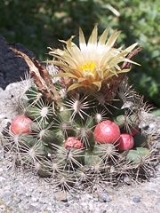
Escobaria missouriensis
Encyclopedia
Escobaria missouriensis, the Missouri foxtail cactus and formerly Coryphantha missouriensis, is a species of low-growing North American cacti
. It is found in along the Missouri River
in the tallgrass prairie
and shortgrass
Great Plains
, from Arkansas
to Montana
, and in the Rocky Mountains
woodlands of Ponderosa pine
(Pinus ponderosa), pinyon-juniper
, and Gambel oak (Quercus gambelii) west of it. It is also native to the Southwestern United States
from Arizona
to Texas
.
Escobaria missouriensis has been extirpated from many of its historically known sites by introduced fire ants, suburban development, brush encroachment following fire suppression, and over-grazing.
Common names
Cactus
A cactus is a member of the plant family Cactaceae. Their distinctive appearance is a result of adaptations to conserve water in dry and/or hot environments. In most species, the stem has evolved to become photosynthetic and succulent, while the leaves have evolved into spines...
. It is found in along the Missouri River
Missouri River
The Missouri River flows through the central United States, and is a tributary of the Mississippi River. It is the longest river in North America and drains the third largest area, though only the thirteenth largest by discharge. The Missouri's watershed encompasses most of the American Great...
in the tallgrass prairie
Tallgrass prairie
The tallgrass prairie is an ecosystem native to central North America, with fire as its primary periodic disturbance. In the past, tallgrass prairies covered a large portion of the American Midwest, just east of the Great Plains, and portions of the Canadian Prairies. They flourished in areas with...
and shortgrass
Shortgrass prairie
The shortgrass prairie ecosystem of the North American Great Plains is a prairie that includes lands from the eastern foothills of the Rocky Mountains east to Nebraska and Saskatchewan, including rangelands in Alberta, Wyoming, Montana, North, South Dakota, and Kansas, and extending to the south...
Great Plains
Great Plains
The Great Plains are a broad expanse of flat land, much of it covered in prairie, steppe and grassland, which lies west of the Mississippi River and east of the Rocky Mountains in the United States and Canada. This area covers parts of the U.S...
, from Arkansas
Arkansas
Arkansas is a state located in the southern region of the United States. Its name is an Algonquian name of the Quapaw Indians. Arkansas shares borders with six states , and its eastern border is largely defined by the Mississippi River...
to Montana
Montana
Montana is a state in the Western United States. The western third of Montana contains numerous mountain ranges. Smaller, "island ranges" are found in the central third of the state, for a total of 77 named ranges of the Rocky Mountains. This geographical fact is reflected in the state's name,...
, and in the Rocky Mountains
Rocky Mountains
The Rocky Mountains are a major mountain range in western North America. The Rocky Mountains stretch more than from the northernmost part of British Columbia, in western Canada, to New Mexico, in the southwestern United States...
woodlands of Ponderosa pine
Ponderosa Pine
Pinus ponderosa, commonly known as the Ponderosa Pine, Bull Pine, Blackjack Pine, or Western Yellow Pine, is a widespread and variable pine native to western North America. It was first described by David Douglas in 1826, from eastern Washington near present-day Spokane...
(Pinus ponderosa), pinyon-juniper
Pinyon-juniper woodland
A Pinyon-juniper woodland is a forest type characteristic of many parts the Western United States, often in higher elevations of desert ecoregions.-Locations:...
, and Gambel oak (Quercus gambelii) west of it. It is also native to the Southwestern United States
Southwestern United States
The Southwestern United States is a region defined in different ways by different sources. Broad definitions include nearly a quarter of the United States, including Arizona, California, Colorado, Nevada, New Mexico, Oklahoma, Texas and Utah...
from Arizona
Arizona
Arizona ; is a state located in the southwestern region of the United States. It is also part of the western United States and the mountain west. The capital and largest city is Phoenix...
to Texas
Texas
Texas is the second largest U.S. state by both area and population, and the largest state by area in the contiguous United States.The name, based on the Caddo word "Tejas" meaning "friends" or "allies", was applied by the Spanish to the Caddo themselves and to the region of their settlement in...
.
Description
Escobaria missouriensis grows up to 30 centimetres (11.8 in) high and forms clumps to 30 centimetres (11.8 in) or greater in diameter. They are generally larger in the Southwest. The plants are primarily unbranched, except eastern populations that can be profusely branched. The spines are bright white, pale gray, or pale tan, weathering to gray or yellowish brown. The plant blooms in April to June, with flowers that are pale greenish yellow to yellow-green with midstripes of green or rose-pink to pale brown.Escobaria missouriensis has been extirpated from many of its historically known sites by introduced fire ants, suburban development, brush encroachment following fire suppression, and over-grazing.
Synonyms
- Cactus missourensis, Cactus notesteinii, Cactus similis
- Coryphantha marstonii, Coryphantha missouriensis var. caespitosa, Coryphantha missouriensis var. marstonii, Coryphantha similis, Coryphantha wissmannii
- Escobaria missouriensis var. caespitosa, Escobaria missouriensis var. marstonii, Escobaria missouriensis var. similis
- Mammillaria missouriensis, Mammillaria missouriensis var. caespitosa, Mammillaria missouriensis var. similis, Mammillaria notesteinii, Mammillaria nuttallii var. caespitosa, Mammillaria similis, Mammillaria similis var. caespitosa, Mammillaria wissmannii
- Neobesseya missouriensis, Neobesseya notesteinii, Neobesseya roseiflora, Neobesseya similis, Neobesseya wissmannii,
Common names
- Ball cactus, Cream cactus, Missouri foxtail cactus, Missouri pincushion

